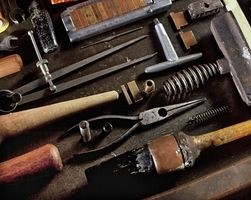Hand Tool Safety Checklist

Hand tools are useful for a wide variety of functions, but the person using them must be very careful at all times, especially in the workplace. A good way to avoid problems is to make a checklist to follow each time a hand tool is used, ensuring that workers follow all of the proper precautions.
General Requirements
General requirements mainly involve proper maintenance of the tools as well as proper safety education of workers. Here is a rough checklist for these sorts of general concerns: --Are the tools checked regularly to ensure they're in good condition? --Are safety procedures for all tools established and made available to all employees? --Is eye protection available and is its use mandated? --Is there a place for tools not in use to be safely stored? --Are employees required to clean tools thoroughly before storing them?
Impact Tools
Impact tools such as hammers and chisels must be kept in good working order as well as replaced once they wear out. Here are some general checklist questions for the use of impact tools: --Are hammers and chisels made from forged steel? --Are carrying pouches available to all workers? --Are all tools that develop mushroomed heads promptly replaced? --Are broken or fractured handles on tools promptly replaced? --Are chisels ground to a 60-degree angle? --Are chisels sharp? --Are claw hammers used only for driving nails?
Wrenches
Wrenches must be used only on nuts and bolts for which they are just the right size. They must also be replaced regularly when they wear out. Here are some checklist questions: --Are worn or bent wrenches replaced? --Is a wide assortment of wrenches available? --Have employees been warned not to try to use wrenches beyond their capacity by adding pipe extensions? --Have employees been instructed not to use wrenches as hammers? --Are vises available to hold pieces in place while connections are loosened and tightened?
Bladed Tools
Bladed tools such as knives and axes are usually most dangerous when improperly stored. Here are some checklist questions: --Are employees aware of the dangers of using knives or axes for purposes other than those for which they are designed? --Are axe handles tight? --Are knives stored in sheaths? Is it prohibited for them to be stored upright in toolboxes? --Are employees instructed never to try to catch a falling knife? --Do employees check to make sure they have a clear area before swinging an axe? --Are employees instructed in the proper method of gripping an axe?
Pliers and Nippers
Pliers and nippers must be used only for their intended uses, and care must also be taken when working with electrical wires. Here are some checklist questions: --Are workers forbidden to use pliers and nippers for anything other than their intended use? --Are the handles of electrician's pliers and nippers insulated?
Saws
Saw blades need to be kept sharp, and they must be used correctly. Here are checklist questions: --Are employees aware of the proper saw to use for different cutting jobs? --Are saw blades sharp?
General Requirements
General requirements mainly involve proper maintenance of the tools as well as proper safety education of workers. Here is a rough checklist for these sorts of general concerns: --Are the tools checked regularly to ensure they're in good condition? --Are safety procedures for all tools established and made available to all employees? --Is eye protection available and is its use mandated? --Is there a place for tools not in use to be safely stored? --Are employees required to clean tools thoroughly before storing them?
Impact Tools
Impact tools such as hammers and chisels must be kept in good working order as well as replaced once they wear out. Here are some general checklist questions for the use of impact tools: --Are hammers and chisels made from forged steel? --Are carrying pouches available to all workers? --Are all tools that develop mushroomed heads promptly replaced? --Are broken or fractured handles on tools promptly replaced? --Are chisels ground to a 60-degree angle? --Are chisels sharp? --Are claw hammers used only for driving nails?
Wrenches
Wrenches must be used only on nuts and bolts for which they are just the right size. They must also be replaced regularly when they wear out. Here are some checklist questions: --Are worn or bent wrenches replaced? --Is a wide assortment of wrenches available? --Have employees been warned not to try to use wrenches beyond their capacity by adding pipe extensions? --Have employees been instructed not to use wrenches as hammers? --Are vises available to hold pieces in place while connections are loosened and tightened?
Bladed Tools
Bladed tools such as knives and axes are usually most dangerous when improperly stored. Here are some checklist questions: --Are employees aware of the dangers of using knives or axes for purposes other than those for which they are designed? --Are axe handles tight? --Are knives stored in sheaths? Is it prohibited for them to be stored upright in toolboxes? --Are employees instructed never to try to catch a falling knife? --Do employees check to make sure they have a clear area before swinging an axe? --Are employees instructed in the proper method of gripping an axe?
Pliers and Nippers
Pliers and nippers must be used only for their intended uses, and care must also be taken when working with electrical wires. Here are some checklist questions: --Are workers forbidden to use pliers and nippers for anything other than their intended use? --Are the handles of electrician's pliers and nippers insulated?
Saws
Saw blades need to be kept sharp, and they must be used correctly. Here are checklist questions: --Are employees aware of the proper saw to use for different cutting jobs? --Are saw blades sharp?
- pue8b4ca201859f29b8aa5484aec45c293.jpg
References
http://www.ehow.com/list_6129882_hand-tool-safety-checklist.html
http://img.ehowcdn.com/article-new-thumbnail/ehow/images/a05/r2/6q/hand-tool-safety-checklist-1.1-800x800.jpg